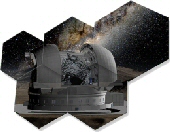Italiano:
Il cratere lunare “Tycho” (dedicato all’astronomo danese Tycho Brahe) è un cratere relativamente piccolo, con un diametro di 85 km e un’età stimata di circa 108 milioni di anni. La raggiera del cratere, estesa circa 1500 km., è stata creata a seguito dell’impatto ed è osservabile anche a occhio nudo dalla Terra. L’asteroide che lo ha generato era grande quasi quanto quello che causò l’estinzione dei dinosauri circa 65 milioni di anni fa e, probabilmente, apparteneva alla stessa famiglia di asteroidi.
Fotografie dettagliate del fondo del cratere mostrano che esso è coperto da una serie incrociata di crepe e piccole colline. I picchi centrali si innalzano a 1.600 metri (5.200 piedi) sopra il pavimento e un picco minore si trova appena a nord-est del massiccio principale. Le osservazioni a infrarossi della superficie lunare durante un’eclissi hanno dimostrato che Tycho si raffredda a una velocità inferiore rispetto ad altre parti della superficie, rendendo il cratere un “punto caldo”, effetto che è causato dalla differenza di materiali che ricoprono il cratere.
L’altro cratere prominente in questa mia foto è Longomontanus, visibile all’estrema destra in alto, nel quale il Sole è sorto da poco e sono visibili affascinanti e lunghe ombre sul fondo del cratere stesso.
Dettagli Tecnici:
Telescopio Astrofaktorja DK20″ @ ~ F/27 – Player One Saturn M camera – Televue Powermate Barlow 2x – Baader R filter – Seeing ~ 7/10 (max.) in R band – sito: Palermo @ my personal Observatory.
***********************************************************************************
English:
“Tycho” lunar crater (named after the Danish astronomer Tycho Brahe) is a relatively small crater, with a diameter of 85 km and an estimated age of about 108 million years. The sunburst of the crater, extending about 1500 km., was created as a result of the impact and can also be observed with the naked eye from Earth. The asteroid that generated it was almost as large as the one that caused the extinction of the dinosaurs about 65 million years ago, and probably belonged to the same family of asteroids.
Detailed photographs of the crater floor show that it is covered by a criss-cross series of cracks and small hills. The central peaks rise 1,600 meters (5,200 ft) above the floor, and a minor peak is just northeast of the main massif. Infrared observations of the lunar surface during an eclipse have shown that Tycho cools at a slower rate than other parts of the surface, making the crater a “hot spot,” which is caused by the difference in materials lining the crater.
The other prominent crater in this photo is Longomontanus, visible at the top right, where the Sun has just risen and fascinating long shadows are visible on the floor of the crater itself.
Technical details:
Telescope Astrofaktorja DK20″ @ ~ F/27 – Player One Saturn M camera – Televue Powermate Barlow 2x – Baader R filter – Seeing ~ 7/10 (max.) in R band – site: Palermo @ my personal Observatory.


